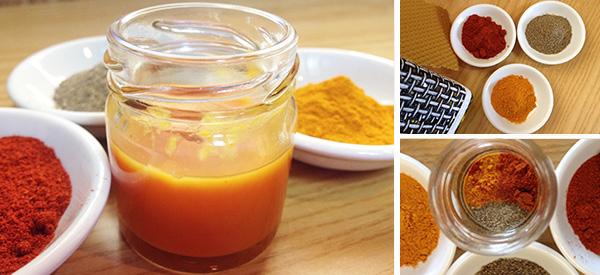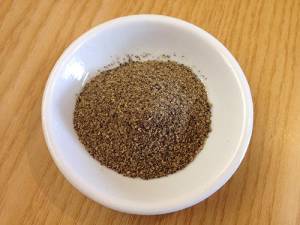
Warming Turmeric and Cayenne Pain-Relief Balm
Warming spices have been used throughout history as pain relievers and even modern medicine utilizes the natural compounds found in these spices as more and more people are looking for alternative, natural treatments to manage their pain.
This is especially relevant for long-term users since the side effects of some prescription non-steroidal anti-inflammatory creams and medications can limit their usage in some people. Studies have shown that many warming spices work just as effectively as some of the over-the-counter treatments, but with minimal risk of any major side effects.
Warming Spiced for Pain Relief
 Numerous studies have shown that the curcumin found in TURMERIC produces significant improvements in a wide variety of skin conditions as well as pain relief. It is a strong anti-inflammatory and anti-oxidant and it’s often found in pain-relief treatments since it doesn’t have any major side effects. When used topically, turmeric can provide localized pain-relief at the same time as protecting, cleansing, and nourishing the skin with its anti-bacterial, anti-fungal, and anti-cancer properties.
Numerous studies have shown that the curcumin found in TURMERIC produces significant improvements in a wide variety of skin conditions as well as pain relief. It is a strong anti-inflammatory and anti-oxidant and it’s often found in pain-relief treatments since it doesn’t have any major side effects. When used topically, turmeric can provide localized pain-relief at the same time as protecting, cleansing, and nourishing the skin with its anti-bacterial, anti-fungal, and anti-cancer properties.
 CAYENNE PEPPER contains capsaicin, which is a well-known pain reliever and anti-inflammatory. When used topically, this strong, warming spice can help to relieve pain by reducing the molecules that signal pain through the nervous system the same way that ibuprofen does. The hotter the pepper, the more capsaicin it contains, so for the most effective balm, use hot cayenne or chili peppers.
CAYENNE PEPPER contains capsaicin, which is a well-known pain reliever and anti-inflammatory. When used topically, this strong, warming spice can help to relieve pain by reducing the molecules that signal pain through the nervous system the same way that ibuprofen does. The hotter the pepper, the more capsaicin it contains, so for the most effective balm, use hot cayenne or chili peppers.
 Piperine, which is found in BLACK PEPPER, significantly slows down the breakdown and oxidization of nutrients and compounds to give your body more time to absorb them. Studies have shown that this is particularly effective for curcumin. For this reason, black pepper is a fantastic addition to this warming turmeric and cayenne pepper balm.
Piperine, which is found in BLACK PEPPER, significantly slows down the breakdown and oxidization of nutrients and compounds to give your body more time to absorb them. Studies have shown that this is particularly effective for curcumin. For this reason, black pepper is a fantastic addition to this warming turmeric and cayenne pepper balm.
Most of the research and trials that showed a substantial decrease in pain used turmeric or cayenne extract or essential oil, so obviously essential oil will be the most effective in a pain-relief balm, but in lieu of essential oil, it’s possible to infuse dried turmeric and cayenne pepper into oil instead.
Related: Homemade Joint And Movement Salve (Learn More)
Carrier Oils
To make this balm, carrier oil is necessary. Any plant-based oil will work, but below are a few suggested oils that are reasonably priced and can be locally sourced in some states.
- Virgin olive oil is the most practical since it can be bought everywhere and it has plenty of health benefits, including maintaining the elasticity of your skin.
- Coconut oil can also be easily sourced and the fatty acids in it are great for healing the surface of your skin, but this means that it lacks strong penetrating abilities.
- Soybean oil has one of the highest absorption levels into our skin so it is ideal of any pain relief balms. It can penetrate deeper into the epidermis to provide relief closer to the joints.
Ingredients:
The quantities listed below make one small cosmetics jar (approximately 50 ml).
- ½ teaspoon of finely ground turmeric
- ½ teaspoon of finely ground cayenne pepper
- ¼ teaspoon of finely ground black pepper
- 3 tablespoons of carrier oil
- 0.2 oz (6 g) of beeswax
Method:
Combine the three spices in a small jar and add the carrier oil. Place the jar in a pot of warm water (no more than 100 °F) and allow the spices to infuse into the oil for at least 3 hours. The oil will darken as it infuses.
The curcumin, the capsaicin as well as the piperine are all oil-soluble, so any small solids that remain (which are mostly from the black pepper) will settle to the bottom so they can be easily removed by decanting the oil (gently pouring off the oil while leaving the solids in the bottom of the jar). In the photo below, you can faintly see how the solids have settled to the bottom of the jar.
Add the beeswax to the oil and sit the jar back in the pot of water again (this time, no more than 150 °F) until the beeswax has melted. Test the consistency by dipping a cold teaspoon into the mixture. Once you are happy with the consistency, remove the jar from the pot of water allow it to cool slowly. OPTIONAL: If you plan on using essential oils, then add them as soon as you remove the jar from the pot of water.
Once the balm has solidified it is ready to use.
Application
Massage into the skin thoroughly 3 – 4 times a day.
Do not apply this warming pain-relief balm to any open wounds or cuts since it will cause a sharp stinging sensation and some of the compounds in the turmeric have anti-coagulant properties, so the blood will take longer to clot.
This balm will stain the skin due to the turmeric and cayenne peppers, but these stains are actually more soluble in oil, so to remove them, massage some oil into your skin and then wash off with soapy water afterward.
Storage and Shelf-Life
This warming balm is best stored in a clean, sterilized glass jar at room temperature. Since it is strictly oil-based, it will keep for at least 6 months.
So next time you have over-strained yourself or want to make your own pain-relief balm, try incorporating some warming spices such as turmeric, cayenne pepper, and black pepper. These spices have been tried and tested throughout the ages with similar results to prescription topical medication.
How To Make A Comfrey Salve For Arthritis and Joint Pain
What Happens if You Put An Onion in Your Socks While You Sleep? (Video)
7 Natural Remedies for Fibromyalgia Pain


I wonder if it will work for an earache?
Triple Oleat Mullein Oil drops in the ear will help with pain and infection. Regular Mullein will work as well but not as strong.
Blown away by and very appreciative of all your this. Thank you!
Any soybean oil? Or is there a specific kind to buy? Thank you in advance.
Can you tell me where is the best place to get the spices?
Thanks!!
Either online or a food co-op that sells organic herbs
Thank you so much for sharing this with us. I’m gathering all my ingredients & supplies now.
Will it work for arthritis?
Do the same ingredients work for arthritis when ingested? I’ve already been putting all those same ingredients except for the cayenne pepper in my oatmeal.
I made this but messed up. I let the beeswax melt completely. I’m wondering if I used too much beeswax because it came out not useable when it solidified. I went back to the directions and was supposed to remove the jar when it was at the right consistency. But it all needed to melt so I don’t get it. Oh well. I had all the ingredients and it didn’t cost anything so it’s all good. I just don’t know how to get to a right consistency if the beeswax isn’t melted. I’m new at this. Better luck next time!
I didn’t keep my eye on it and it got too hot. I think that is what went wrong. Do be sure you watch it.
I got the same issue
Just add some infused oil until you get it to the best consistency for you. I take some out and put it in the fridge. Test after 25 minutes and then add more if needed. Measure everything you add so you remember for next time.
It would;d be most helpful if, when publishing these fine recipes, they could be laid out so that they could be printed on an A4 sheet of paper. Economic, environmentally friendly and easier to file so may achieve wider utilisation
Yes it would. I am currently copying and pasting but always left with a blue background.
I am able to save as a PDF, but then. I’m using an Apple. Copy and drop into a Word document; you may be able to avoid the blue background that way.
thank you so much can’t wait to
make this for gifting
The reason for the extreme stiffness is the beeswax amount is not correct. It reads 2 oz or 6 g. 6 g is 0.21 oz NOT 2 oz
If this comment is up here twice, I apologize. I’m not sure what happened to the first one.
Thank you. Maybe that’s why Donna’s didn’t work 🥴
So, I tried this, but didn’t have the beeswax, so I used the olive oil for the carrier oil, and then coconut oil in place of the beeswax. (Because the coconut oil gets hard when cooled), and it did whip up into a nice creamy consistency. The problem is, it doesn’t work…. it doesn’t warm the skin at all. Isn’t it suppose to get hot, or at least warm when you rub it in? Like Ben gay? Any suggestions as to what I did wrong? Surely the beeswax doesn’t make the heat?
Following
Love this idea we make our our salves & this is great
Can we use shea butter instead of beeswax
Hi Debra,
To start, beeswax is a wax while Shea butter is an oil.
Soy wax is all-natural and can serve as a substitute for beeswax. It is most commonly found in candles, but it can also replace beeswax in salves and other cosmetics. It is no harder than beeswax, so it can be used in equal amounts in recipes.
Cocoa butter is a good substitute for beeswax if you’re looking to create a vegan product. Shea butter melts on contact with the skin, making it a more popular choice for lip balms.
Many blessings and good health!
Why is Castor oil not listed as a carrier oil?